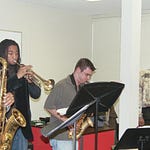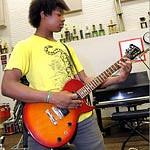I read this morning in the New York Times that Sam Ash Music Stores are closing.
If you ask any jazz, rock, classical, country, blues, or world musician who needed gear while in NYC of the 70’s. Sam Ash Music was the place.
As the Woodstock generation was rising to an incandescent peak, Sam Ash and Manny’s Music, the primary purveyors of Rock’n Roll gear rose to commercial dominance along with the rising fortunes of a newly-minted rock industry.
Reading today about Sam Ash sent me to the archives where I found the 45RPM vinyl recording that Bill Chase and I produced for the Gibson Guitar Company in 1974. What follows is the story of how this particular recording came to be available at Sam Ash, Manny’s and practically every other music store in the US. Enjoy.
Trumpets can be loud so WATCH YOUR VOLUME. Enjoy 2 minutes and 55 seconds of commercial audio art.
While Chase was in the studio in the Winter of 1973, I met Bruce Bolan. A pretty good musician in his own right, Bruce worked with the Gibson guitar company on a new bass guitar with pickups that, according to rumor, sounded unlike anything commercially available at that time.
While I was a pretty committed player of Fender® basses, I agreed to try the new Gibson bass (code named The Ripper model no. L9-S). Unlike the Fender Precision bass, the L9-S included something called a “Q-system” which was designed to change the polarity relationship between the two “humbucking” pickups. Almost akin to turning your sound ‘inside out.’
Pretty high tech for 1974….and I didn’t like it at first. It couldn’t reproduce the burnished depth of the Fender but the more I used it, I had to admit that it was certainly distinctive and super-playable.
Bolen proposed that Bill and I create a track designed to highlight the sound of the new Ripper bass. That was my introduction to the world of music-for-commerce and commercial endorsement. Carlos Santana, by the way, endorsed the six-string version of this instrument called the L6-S.
After coming up with the bassline/melody for the song (titled Bass-Meant), Bill crafted and arranged the horn parts. The down home R&B rhythm groove that Tommy Gordon and I created for the track, compelled Bruce Bolen to grab a guitar and throw in some great parts near the end of my solo. [you can hear him enter 2 minutes into the track]
[Tech notes]
After using the Ripper bass in the studio and on the bandstand, I grew to appreciate it’s ability adapt tone-wise to almost any situation. Using a Crown® D-150 power amplifier and a MOOG® parametric equalizer/preamplifier I could craft virtually any bass sound I needed.
50 years later, I still have The Ripper Bass which may be the most solid guitar I own as far as tonal accuracy. The pickups are rock solid and coupled with modern tone-shaping tools, I have an almost unlimited array of tones available from an instrument brought to market during the depths of the energy crisis.
(While my bass still sounds great, it’s largely because I had to replace every bit of the internal wiring. Built during the 1973-4 Energy Crisis, substandard plastic resulted in extremely poor quality wiring. The original vinyl recordings of Bass Meant had similar quality problems.)
Using modern audio restoration tools, I was able to restore a sense of the original ‘sound stage’ while cleaning up the ‘click and pop’ audio residue from the original vinyl recordings. Fun stuff.
If you haven’t done it before, go back to the top and listen to “Bass-Meant.”


















Share this post